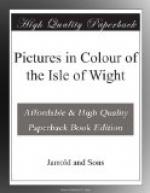[Illustration: Steps to the Keep, Carisbrooke Castle.]
STEPS TO THE KEEP, CARISBROOKE CASTLE.—As a memorial of a bygone age how interesting are the steps to the keep, the last resort of the besieged, from which it would be difficult to dislodge them, without great loss. The well which furnished them with water is now dry, but can still be seen. The battlements furnish the visitor with a magnificent view of the country in every direction. The steps, seventy-two in number, are somewhat steep. The walls are covered with climbing plants. Shelter is afforded by trees and bushes, while access is given at the back of the ancient buildings in the Castle, to facilitate escape in case of surprise.
[Illustration: Carisbrooke Village.]
CARISBROOKE VILLAGE.—The village of Carisbrooke is beautifully situated. The Church, embowered among the trees, stands on an elevated site close to the Priory, with which it was associated. The Chancel was destroyed in Queen Elizabeth’s reign by Lord Walsingham, whose obligation it was to have kept it in repair. The Pulpit is a relic of Puritan times, dated 1658, very small and plain. It was evidently not intended for the preacher to sit down, as nails stick up in the very small seat. The Lukely stream runs through the village. The view here shown is taken from the Beech Grove, a very beautiful walk leading to Carisbrooke Castle.
[Illustration: Quarr Abbey, W. Ryde.]
QUARR ABBEY, W. RYDE.—The distance of the Abbey from Ryde is about three miles. It is a favourite walk from Spencer Road, via The Lovers’ Walk, past Binstead Church, through Quarr Wood. This portion is occupied as a farm, but remains of the old Abbey are scattered about, portions still standing to testify its extent and importance. The walk may be continued through the archway on to Fishbourne. In the wood the daffodil is plentiful, primroses, lungwort, and the blue iris also abound in their season. The Wood has been very extensively quarried for the limestone, with which Winchester Cathedral and many Churches were built. There are pathways through the Wood down to the shore, forming very pleasing vistas through the overhanging trees.
[Illustration: Spencer Road, Ryde.]
SPENCER ROAD, RYDE.—It is an advantage for a town to possess pleasant shady walks within a short distance of its main streets. Ryde is favoured in this respect. Within five minutes’ walk from the Town Hall, passing St. James’ Church, is Spencer Road. It is a favourite promenade, enjoyed by residents and visitors alike. A morning stroll in spring when birds are singing from every bush and tree is very delightful. It is a fine avenue extending several hundred yards and opening out into the main road to Newport. By entering the gate on the right at the junction, the walk may be continued past Binstead Church through Quarr Wood to Quarr Abbey.
[Illustration: Ryde, from the Pier.]




